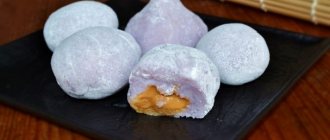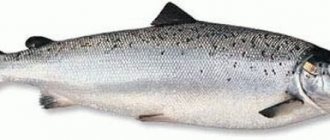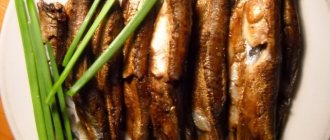Group categories: Japanese cuisine
Rice is the staple culinary product of Japan. Knowing how to cook it properly is an important first step to becoming a master of Japanese cooking. Ideally cooked Japanese rice should be light, fluffy and slightly sticky. It is in this consistency that it is used to prepare many dishes. The Japanese eat rice, which is more sticky than in some other Asian countries.
This is because it is eaten using chopsticks, and its stickiness makes it easy to pick up from a plate, as well as form into balls or sushi. As a rule, round-grain varieties of the product are used. When preparing rice, certain additives are usually used to give the grains a special taste and aroma. This creates the basis for many dishes, which are then prepared with the addition of eggs, meat, fish and/or vegetables.
| Additive | What is |
| rice vinegar | It has a unique aroma and a mild sweet and sour taste, and has a low strength (often up to 4-5%) |
| kombu | dried seaweed, which is used as a flavoring when cooking cereals, and then removed |
| sake | strong rice wine with a pronounced aroma and slightly tart taste |
| dasi | broth made from dried tuna fillets, crushed into thin flakes |
The Japanese mainly consume white rice (hakumai) and only occasionally brown rice (genmai), which retains the bran and germ. Genmai is denser and has a higher nutritional value due to the fiber, vitamins and minerals it contains.
In Japanese cuisine, rice comes in a thousand and one forms. In addition to the world famous sushi, it is popular in combination with vegetables or curry sauce. Fried with egg, vegetables and meat, it forms a dish called chakhan. Prepared in a triangle shape and filled with fish or dried plum, onigiri is a convenient snack that can be eaten on the go.
Rice with vegetables or gohan
Japanese rice dishes are almost always easy to prepare.
For example, this recipe only takes 20 minutes.
What ingredients will you need?
- 1 tbsp. l. vegetable oil;
- 2 cloves garlic (chopped);
- 1 small leek or onion (finely chopped);
- 1 small carrot (finely chopped);
- 300 g cooked Japanese rice;
- 1 tbsp. leafy greens, finely chopped;
- 2 large eggs (beaten);
- 1 tbsp. l. soy sauce;
- salt and ground white pepper (to taste).
Step-by-step cooking process
- Add oil and garlic to a wok or large frying pan over medium heat and cook for 1 minute.
- Then add the onions and carrots and fry for 3-4 minutes until the vegetables are soft (but they should still be crispy in the middle).
- Next, add the cooked rice and leafy greens and stir until the ingredients are combined with the rice.
- Next, you need to move the rice to the side and pour in the eggs and fry them, stirring constantly and breaking them with a spatula, until they are almost completely cooked.
- Fried eggs must be mixed with rice and soy sauce added.
- Season the finished dish with salt and pepper and stir until the sauce and seasonings are evenly distributed throughout the fried rice.
What can I add?
Japanese fried rice is versatile. You can put any vegetables that are available in it - Chinese cabbage, green beans, sprouts, and so on.
How to serve
This dish should be served immediately, hot. If desired, you can sprinkle it with fresh herbs.
Braised pork (butaniku no maru ni)
600-800 g pork tenderloin, 1.5 tbsp. tablespoons vegetable oil, 1.5 cups water, 1/4 cup shoyu, 1/3 cup vodka, 5-6 pieces of peeled ginger, 2-3 chopped green onions, 1/2 teaspoon salt, 3 black peppercorns.
Fry pork evenly in oil over medium heat. Pour in water, shoyu and vodka, reduce heat, add ginger, onion, salt, pepper and cover with a lid. Simmer the pork for 1.5–2 hours, stirring occasionally and adding water so that it covers the meat at least halfway. Cool the finished pork and cut into pieces.
From eggs
Japanese rice and egg dishes are called omumeshi and omuraisu. They are boiled and then fried cereals mixed with an omelet. You can prepare this dish at home very quickly and easily. One version calls for frying rice with eggs, shredded cabbage and diced bacon, then topping it with sweet and salty okonomiyaki sauce.
Japanese rice dishes are made with eggs, such as omuraisu omelette.
Preparation next.
What ingredients will you need?
- 2 tbsp. boiled white rice for sushi (350 g);
- 4 tbsp. l. (60 ml) sunflower or rapeseed oil, divided;
- 0.5 tbsp. chopped yellow onion (100 g);
- 0.5 tbsp. (40 g) diced green cabbage;
- 2 strips (50 g) thinly sliced fresh pork belly or bacon;
- 0.25 tbsp. (60 ml) okonomiyaki sauce, plus more for garnish;
- 1 leek, thinly sliced;
- cayenne pepper to taste;
- kosher salt and coarsely ground black pepper;
- 4 large eggs, beaten with a pinch of salt;
- kewpie mayonnaise and crumbled nori leaves for serving (optional).
Step-by-step cooking process
- If using pre-cooked and cooled rice, place it in a bowl and crumble it into individual grains.
- Next you need to heat 1 tbsp. l. (15 ml) vegetable oil In a medium carbon steel or nonstick frying pan over high heat until slightly sizzling, add half the rice and stir-fry until pale brown, toasted and slightly elastic, about 3 minutes.
- Then you need to transfer it to a medium-sized bowl, and repeat the same with another spoon of oil and the remaining rice.
- After this, you need to pour another spoon of oil into the frying pan, return the container to high heat and heat, add the onions and cabbage into it and cook, stirring, for about 3 minutes, until the vegetables are soft and slightly browned.
- At this stage you need to add the brisket or bacon to them and fry, stirring, for about 3 minutes, until the pieces turn light brown.
- Next, return the rice to the pan and mix evenly with the vegetables and bacon, pour in the okonomiyaki sauce and cook, stirring, until the liquid has reduced and is absorbed into the grains.
- Then you need to add the leeks and season everything with black and cayenne pepper and salt, transfer to a small heat-proof bowl, packing the rice mixture tightly.
- After this, the container must be turned over onto a flat plate so that the fried rice is laid out in a beautiful semicircular shape.
- Wipe the pan with a paper towel and return to medium-high heat, add the remaining tablespoon of oil and heat well, add the eggs and quickly stir with a spatula, shaking the pan.
- Use a spatula to break up any tough lumps, and stop stirring once the eggs are very soft and tender (but still loose enough to come together). This will take 1-2 minutes.
Using a spatula, carefully spread the fried eggs in an even layer on the surface of the cooked rice, garnish with okonomiyaki sauce, kewpie mayonnaise and crumbled nori leaves, and serve immediately.
Classification of dishes in Japanese cuisine
Japanese cuisine is very diverse and multifaceted. And in contrast to the usual division of dishes into first, second, third (and “compote”), the Land of the Rising Sun has completely different traditions. There is no strict order in which certain dishes are served on the table, and participants in the meal can start with any treat they want. The only rule is that the meal ends with soup or rice. And the dishes themselves are combined with each other according to the principle of their preparation. Let's take a closer look at how dishes are grouped in Japanese cuisine.
YAKIMONO
“Yaki” in Japanese means “fry”, “fried”, and “mono” means “thing”. This is a very common way of cooking food in Japan - frying over an open fire or grilling. Often a brazier, grill or teppanyaki tile is placed directly on the dining table (like a Chinese samovar Hogo) so that all diners can take part in the preparation of the dish and immediately taste it in the heat of the heat. A wide range of dishes are prepared using the yakimono method: kushiyaki and yakitori skewers from various products strung on bamboo skewers, Japanese okonomiyaki pizza, takoyaki dough balls filled with octopus and vegetables, a large number of teppanyaki dishes (thinly sliced vegetables, meat or fish fried on a wide flat teppan tiles, which are installed directly on the table, and then immediately enjoy hot foods dipped in your favorite sauces), Japanese omelettes, steaks, teriyaki dishes glazed with sweet sauce, fried gyoza dumplings, yakiniku dishes and many other treats.
Yakiniku dishes (translated as “fried meat”) are extremely popular in Japan. The meat is cut into slices or thin strips and cooked over an open fire. Japanese restaurants that specialize in Yakiniku (and there are quite a few of them) traditionally serve meat and other foods raw, properly cut and prepared for frying. Restaurant guests fry the meat themselves on a special fryer called a hibachi. It is placed in the center of the table. It is a square or round clay container, spacious and deep - it is filled with burning coals. A metal grid is placed on top of the hibachi, on which pieces of meat and other products are laid out. During the frying process, the participants in the meal themselves turn the pieces of food to the other side using special small tongs. Products cooked over fire retain their natural taste and have a slight smoky flavor. Dipping sauces for fried meat are of great importance in a Yakiniku-style dinner - with their help you can extremely diversify the flavor range of the meal. In Japan, sauces for Yakiniku are produced in a variety of flavors - even your eyes widen from such a choice.
NABEMONO
"Nabe" means "pot" in Japanese. Nabemono means cooking in a pot. Typically, pots are made of clay, which retains heat for a long time, keeping food hot (such pots are called “donabe”). Cast iron pots (“tetsunabe”) are also common. This cooking method is very popular during cold seasons. The Japanese cook soups, thick stews, stews and simmered dishes in pots, and also bake dishes in them in the oven and oven. In Japanese cuisine, there are a great many recipes for dishes in pots.
Varieties of nabemono dishes that are very similar to the Chinese samovar Hogo are very famous outside of Japan - these are dishes such as sukiyaki and shabu-shabu. The principle of their preparation is the same. Participants in the meal are served prepared, thinly sliced raw foods (from mushrooms and vegetables to meat and tofu, and noodles are also served). In the center of the table, on a heated tile, there is a pot (or cauldron) in which a special broth with spices is boiling. Eaters put food into it, which is cooked right on the table. When the food is ready, you can enjoy it by dipping it in various sauces. On cold evenings, it is very pleasant to sit with friends or family in a warm room over a hot pot and cook food together while having fun and sincere conversations. Sukiyaki differs from shabu-shabu in the richer and brighter taste of the broth, with salty and sweet flavor notes. Products in such a broth are cooked (stewed) longer so that they take on the taste of the broth. Often all the products are put into the broth together and cooked together, but in different parts of Japan they still cook it differently - they can first fry the meat in a pot in oil, and then cook vegetables and mushrooms in it. As for shabu-shabu, the broth is not at all sweet and is prepared with a minimum of seasonings. And thin slices of meat are kept in boiling broth for only about a minute - this is enough for the meat to cook. Usually the main meat ingredient is beef. After the broth is saturated with meat juices, the remaining products are dipped into it. First, vegetables, mushrooms, and herbs are cooked in it (immediately taking out the food when ready and transferring it to your plate). Then, when the broth has been enriched with vegetable juices, at the final stage the noodles are placed in the pot.
AGEMONO
Agemono is the process of cooking food in hot oil, as well as deep frying. The famous Japanese dish Tempura is called agemono. Tempura (Japanese: 天ぷら) is a series of Japanese dishes made from a variety of products (shrimp, fish, seafood, meat, vegetables, tofu, fruits, etc.), which are dipped in a special batter and then deep-fried until golden brown. The most popular are shrimp prepared in this way. The soft, elastic meat of the shrimp goes well with the delicious crispy crust of the batter.
The world famous Japanese Tonkatsu cutlets are also agemono. They are traditionally prepared from a single piece of meat (usually pork schnitzel), which is dipped in flour, raw egg and Japanese breadcrumbs (they differ from domestic breadcrumbs in size and shape - unlike our “crumbs”, Japanese breadcrumbs resemble large prickly wood chips in appearance ). The cutlet is then deep-fried, and it acquires the recognizable prickly, fluffy “coat” of breadcrumbs.
Agemono also includes karaage dishes - these are pieces of chicken, or fish, or octopus, or other meat, which are first marinated, then rolled in flour and deep-fried. The dish acquires an appetizing crispy crust, under which lies juicy tender meat.
The Japanese are very fond of korokke - Japanese cutlets breaded in breadcrumbs and deep-fried. Usually korokke is prepared from mashed potatoes (like zrazy), often with the addition of minced meat, chopped vegetables, and seafood to this puree. Such food is considered ordinary, everyday food.
In addition to dishes deep-fried in batter, agemono also includes dishes without a dough crust, in which products (vegetables, fish, seafood, meat, mushrooms, tofu) are cut into pieces and fried in oil (in a small amount compared to deep-frying). ).
NIMONO
This is a special type of dish that is stewed for a long time, usually with the addition of traditional Japanese ingredients such as sake, soy sauce, sugar and the Japanese thick sweet rice wine mirin to the stewing sauce. Other ingredients that add flavor to the braising sauce vary from recipe to recipe, including miso paste, fresh ginger root, egg yolk, sesame oil, tuna flakes, spices, and other ingredients. Typically, vegetable products, fish and meat are prepared in this way. The most famous nimono dishes for connoisseurs of Japanese cuisine are nikujaga (stewed meat and potatoes in sweet sauce), stewed pork kakuni, nizakana (fish stewed in sweet soy sauce), and the Okinawan dish soki (stewed pork ribs).
SASHIMI AND SUSHI
Sashimi is a Japanese dish of raw sea fish, raw squid, boiled octopus and other seafood, cut into small slices. They are traditionally served with soy sauce and the fiery Japanese seasoning wasabi, as well as fresh vegetables. Sushi is a dish of specially prepared rice and seafood (most often raw fish, but for those who do not like it, there is always a choice of other seafood - for example, boiled or fried shrimp, or fried eel, etc.). Sushi is also served with soy sauce and wasabi. There are quite a few types of sushi - they depend on the shape of the sushi itself, on the combination of ingredients and design of the sushi, on the types of fillings, etc. In addition to the essential rice and seafood, some types of sushi can be supplemented with nori seaweed, sea fish caviar, Tamagoyaki omelette, pickled and fresh vegetables.
SALADS
Japanese cuisine is distinguished by a wide variety of salads, which are prepared from completely different products - vegetables, fruits, mushrooms, poultry, meat, seafood and fish. The products are almost never heat-treated, observing one of the basic principles of Japanese cuisine - preserving the original taste of the products. If heat treatment is present, it is minimal - for example, blanching vegetables for a crunchy texture or grilling vegetables such as eggplant. Salads are flavored with various dressings; you can often find sweet or salty flavors of dressings - they are usually prepared on the basis of soy sauce, sake, sugar (or mirin), rice vinegar, aromatic oils, spices, chopped seaweed, sesame and other traditional Japanese cuisine ingredients are added. . Gomadare sesame sauce is very popular as a dressing. (Recipes for the most popular Japanese dressings can be found here). Under the influence of Western cuisine, atypical and rather “heavy” compared to national potato salads, seasoned with mayonnaise (the Japanese prefer to use soy), appeared in Japan. Salads are usually served as a side dish with meat or fish dishes.
NOODLES, SOUPS AND BROWS
A traditional Japanese meal is unthinkable without soup. The base of most Japanese soups is Dashi fish stock, made from Kombu seaweed and katsuobushi smoked tuna flakes. Chicken and beef broths are also prepared, but soups made with Dashi broth are the most common and favorite. Especially miso soups - with the addition of miso paste. Noodles in meat or vegetable broth are one of the most popular options for serving noodles in Japanese cuisine. Most often these are wheat ramen egg noodles or wheat udon noodles. As for buckwheat soba noodles and string-thin wheat noodles somen, on the contrary, they are most often served cold.
RICE DISHES
And although rice dishes are prepared in Japan in many ways, we still believe it would be correct to place rice-based dishes in a separate category, since rice is the No. 1 product in Japanese cuisine, the king of all products. In Japanese, the phrase “cooked rice” (“gohan”) means “food” in a broad sense, just as in Russian the word “bread” is used for this.
The most common rice side dish is plain, unleavened short-grain rice, boiled in water or steamed. It is served with almost any dish. It should always be on the table, just like we have bread. Sometimes (at the request of consumers) such rice is flavored with a dry mixture of spices, which is called “furikake” in Japanese. Such seasonings have a rich composition - they are based on dried and powdered seaweed and sea fish, salt, and sesame seeds. But additional ingredients vary depending on the seasoning recipe - it can be ground chili, dried and powdered vegetables, miso powder, dry soy sauce, dry Hondashi fish broth, sugar, spices and many other components.
One of the most popular rice dishes in Japan is curry. Japanese curry is different from Indian, Thai and others. It is not hot, not very spicy, slightly sweet and has a very rich and pleasant taste. There are quite a lot of curry recipes in Japan; this dish is popular among people, and you can find it on the menu of any Japanese restaurant.
Chahan is a type of Japanese fried rice with all kinds of additives (toppings) - from pieces of meat and ham to vegetables, tofu, and mushrooms. The Japanese adopted this method of cooking rice from the Chinese, where dishes made from the remains of yesterday's boiled rice, fried in a wok with the addition of other products and frying sauce, are extremely popular. Only unlike the Chinese, the Japanese prefer to use their favorite sticky short-grain rice, and prepare stir-fry sauces from their traditional Japanese seasonings.
The Japanese also prepare rice porridge (rice broth) with the addition of herbs and various additional products; they are very popular as a therapeutic food for people who need to regain strength after illness.
Countless different dishes are prepared based on rice in Japanese cuisine. Some of the most unusual and unfamiliar treats for Europeans include delicate Japanese mochi cakes made from rice flour, Japanese rice and fish soup Ochiazuke, in which green tea with a seaweed flavor is used instead of broth, Omuraisu omelette with fried rice inside and Japanese rice burgers (in which instead of a bun, rice is used, laid out in the form of a burger patty).
Japanese sweets are definitely worth mentioning. They are not served, as in Europe, at the end of the meal - the meal is usually completed with soup or rice. Sweets are an addition to tea in the morning or evening as a separate snack. Japanese desserts are so interesting and unusual that we will definitely talk about them in a separate article.
From meat and rice
Japanese rice dishes with added meat are most often gyudon.
To prepare it, thinly sliced fatty beef is simmered in a sweet mixture of mirin and soy sauce, then mixed with boiled rice and a fried egg.
What ingredients will you need?
- odorless vegetable oil (for example, sunflower or rapeseed);
- 2 medium onions (very thinly sliced);
- 450 g very thinly sliced beef (fatty cut of carcass);
- 2 tsp. Sahara;
- 2 tbsp. l. Mirina;
- 2 tbsp. l. soy sauce;
- 1 tbsp. dashi broth (can be replaced with beef or chicken broth);
- 4 eggs;
- 4 tbsp. cooked white rice (preferably short or medium grain);
- 1 leek (chopped);
- 2 tsp. toasted sesame seeds (optional).
Step-by-step cooking process
- It is necessary to heat 2 tbsp. l. oil in a large frying pan over moderate heat and fry the chopped onion in it for about 10 minutes, stirring often.
- Next, add the beef and sugar and fry until the pieces of meat are browned.
- After this, you need to pour in mirin, soy sauce and broth, boil the liquid and simmer for about 10-15 minutes until the broth turns into a liquid sauce. During the cooking process, you need to taste the mixture and adjust the amount of seasonings, if desired, add a little more soy sauce.
- Meanwhile, heat a couple more tablespoons of oil in a separate cast iron skillet or non-stick container and fry the eggs without stirring or touching. If necessary, they can be prepared in batches. The yolks must remain liquid!
- When the beef is ready, divide the rice between 4 bowls and top each with the meat in the sauce and a fried egg, garnish with chopped leeks and toasted sesame seeds.
Noodles
Noodles are found in three main types in Japan - ramen, udon and soba.
Wonton ramen (noodles with Chinese dumplings)
Ramen most often comes in a rich pork broth with thinly sliced meat. If desired, bamboo shoots and raw egg can be added to the noodles. The dish is very tasty and satisfying; one serving can easily replace a hearty multi-course lunch.
Ramen in rich pork broth with raw egg
Soba is a grayish buckwheat noodle, and udon is a white wheat noodle. Since ancient times, they have been the same basis of Japanese cuisine as rice.
Buckwheat noodles
Chicken and rice
The Japanese dish oyakodon consists of rice, chicken and eggs, and is similar in appearance to pizza.
Moreover, its preparation requires a very small amount of ingredients, and it will be completely ready in 20 minutes.
What ingredients will you need?
- 1 tbsp. (240 ml) homemade dashi or chicken broth;
- 1 tbsp. l. (15 ml) soy sauce, plus more to taste;
- 2 tbsp. l. (30 ml) dry sake;
- 1 tbsp. l. (15 g) sugar, plus more to taste;
- 1 large onion, sliced (about 170 g);
- 340 g skinless, boneless chicken thigh fillet, cut into thin slices;
- 3 thinly sliced leeks;
- 2 stems mitsuba (optional);
- 3 to 4 large eggs.
To submit:
- 2 tbsp. boiled white rice;
- togarashi.
Step-by-step cooking process
- Combine dashi, soy sauce, sake and sugar in a small frying pan and heat to a boil over high heat, add onion to mixture and cook, stirring occasionally, until softened, about 5 minutes.
- Then add the chicken pieces and continue cooking, stirring and turning the fillets occasionally, until they are cooked through and the broth has reduced in volume by about half, 5–7 minutes.
- Next, you need to put half the leek and all the mitsuba there (if used), then season the broth to taste with soy sauce or sugar if desired. The sauce should have a balanced sweet and salty taste.
- After this, you need to turn the heat down to moderate.
- In a medium bowl, lightly beat the eggs with chopsticks and pour into the pan in a thin, steady stream, holding the chopsticks over the edge of the bowl to distribute the egg mixture evenly.
- Cover the pan with a lid and continue cooking until the eggs reach the desired degree of doneness (about 1 minute for a soft consistency and 3 minutes for a firm consistency).
- To serve, place the cooked hot rice in one large bowl or 2 separate deep serving plates, place the egg and chicken mixture on top, pouring the excess broth from the pan over everything.
- If desired, add an extra egg yolk to the center of each serving, and garnish the dish with the remaining half of the chopped leek and togarashi, and serve immediately.
Japanese tea
Tea in Japan is mostly drunk green, and sugar or milk is almost never added to it. There are several main varieties:
Bancha is the simplest and cheapest variety. A mixture of bancha and fried rice is called genmaicha. You can buy it in cafes, train stations, supermarkets, etc.
Sencha is a higher quality and more expensive tea, usually served in decent restaurants.
Matcha is a good green tea, ground to a powder. It is usually used for a tea ceremony, and a cup of such tea is sometimes included in the program of visiting some tourist places (for example, the villa of actor Okochi Sanso in Kyoto).
Gyokuro is the most “respectable” variety of Japanese green tea; it is drunk only on major holidays.
From fish and rice
Japanese rice and fish dishes are an example of the classic culinary tradition of this country. Many recipes offer to prepare a very simple, healthy and tasty lunch in a short time, using a small amount of ingredients.
What ingredients will you need?
- 3 tbsp. boiled rice;
- 1 piece of salmon fillet (about 200 g);
- 1 tsp. sake;
- 0.25 tbsp. teriyaki sauce;
- a handful of cabbage leaves or any vegetables for serving;
- 2-3 radishes;
- 0.25 tbsp. edamame;
- 1 tsp. sesame seeds for decoration;
- 1 tsp. chopped green onions;
- olive oil.
Step-by-step cooking process
- It is necessary to pour a spoon of sake over the salmon fillet and set aside for a while.
- Cabbage and radishes should be chopped very thin and soaked in water.
- Then you need to remove excess sake and moisture from the surface of the fish with a kitchen paper towel.
- Heat the olive oil in a frying pan over moderate heat and fry the salmon in it until cooked.
- Then you need to transfer the fillet from the frying pan to a plate and cut it into small pieces.
- You need to wipe the pan with a paper towel and heat the teriyaki sauce in it, put the pieces of fish there and mix thoroughly.
Boiled rice should be divided into portioned bowls, chopped vegetables and pieces of fish should be placed on top along with the sauce, and served immediately.
Unagi
Unagi is a Japanese river eel, the fillet of which is treated with a special sauce and fried for a long time over lukewarm coals - as a result, the fish turns out almost smoked.
Network Unagiya in Kyoto
In ordinary unagiy cafes, the dish is most often found in two forms: either on a skewer, or in a special square bowl on a bed of rice.
In expensive restaurants, the range of unagi dishes is much larger, plus the fish itself can be selected in a special aquarium.
At markets like Tokyo's Tsukiji or Omicho in Kanazawa, eel fillets can be purchased whole or in the form of skewers. In my opinion, “correct” unagi is one of the most delicious dishes of Japanese cuisine, and not trying it while in Japan is completely unforgivable.
Tuna and rice
Chahan or Japanese fried rice is a simple, quick to prepare and easily adaptable dish. To make it not only tasty, but also beautiful, it is recommended to add any 3 vegetables of different colors to it. For this, carrots, onions, white or Chinese cabbage or green peppers are traditionally used.
You can add ham, shrimp or other meats as a source of protein, but the best option is tuna fillet.
What ingredients will you need?
- 3 tbsp. cooked rice;
- 1 large carrot;
- 3-4 leaves of Chinese cabbage;
- half a large leek;
- 1 can of tuna without oil;
- 1 egg;
- soy sauce;
- salt;
- Sesame oil.
Step-by-step cooking process
- White rice needs to be boiled.
- All vegetables should be finely chopped and fried over moderate heat with a small amount of sesame oil and 2 pinches of salt.
- Next, you need to add a can of tuna, mix everything thoroughly and cook together for a few minutes.
- Then you need to turn down the heat, put cooked white rice in the pan, pour in 4-5 tbsp. l. soy sauce (or to taste) and mix well.
- After this, you need to pour in 1 raw egg, mix with rice and vegetables and fry until it becomes dense.
Kaiseki
A special mention should be made of kaiseki - although this word does not denote any specific dish or base ingredient, but rather its quality, appearance and presentation.
Kaiseki is the top of the Japanese culinary pyramid and the crown of the centuries-old development of Japanese cuisine. It is a long meal in elegant interiors with several courses, each of which looks like a work of art - sometimes it is a real culinary ikebana with references to literature, painting and history. The dishes themselves that make up kaiseki are traditional - sushi, tempura - but their quality is the highest (as is the price). Kaiseki in a good restaurant is unlikely to cost less than 15,000 yen - however, sometimes in Tokyo you can stumble upon mini-kaiseki for only 5,000-7,000 yen.
Japanese curry with rice
Japanese curry (or kare as it is called in Japan) is one of the country's most popular instant dishes. It offers a taste of a bold and vibrant combination of spices. This recipe is based on a classic Japanese curry with succulent pieces of chicken, tender carrots, sweet peas and potato slices.
Spices can be varied to suit your own taste.
What ingredients will you need?
- 2 tbsp. l. (7 g) whole coriander seeds;
- 1 tbsp. l. (6 g) whole cumin;
- 1 tbsp. l. (6 g) whole fenugreek seeds;
- 2.5 tsp. (6 g) cardamom seeds;
- 2 tsp. (5 g) whole black peppercorns;
- 0.5 tsp. (2 g) fennel seeds;
- 1 piece of cinnamon measuring 5 cm (3 g);
- 3 carnation stars;
- half a star anise pod;
- 1 or 2 strips (1 g) dried orange zest (optional);
- 2 tbsp. l. (16 g) ground turmeric;
- from 0.25 to 0.5 tsp. (1 to 2 g) chili powder, depending on the desired spiciness and its taste;
- a pinch of grated fresh nutmeg;
- 450 g chicken thighs without skin and bones;
- kosher salt and coarsely ground black pepper;
- 2 tbsp. l. (30 ml) vegetable oil, a little more if necessary;
- 1 large yellow onion (450 g), diced;
- 225g carrots (3 medium), peeled and cut into 1cm thick pieces;
- 1 liter of homemade chicken broth;
- 1 liter of homemade dashi or semi-finished product;
- 450 g potatoes, peeled and cut into 2.5 cm pieces;
- half (180 g) of an apple, peeled, cored, chopped or pureed;
- 0.5 tbsp. unsalted butter (110 g);
- 0.5 tbsp. all-purpose flour (55 g);
- 1 piece of peeled fresh ginger (5 cm), finely grated;
- 3 tbsp. l. (25 g) curry spice mixture;
- 1 tbsp. frozen green peas (160 g), optional;
- boiled short grain rice;
- pickled ginger and/or rakkyo (pickled Japanese onions) to serve.
Step-by-step cooking process
- Coriander, fenugreek, fennel and cumin seeds, as well as black peppercorns, must be placed in a dry, hot frying pan and fried until an intense aroma appears.
- Next, in a spice grinder, grind the coriander, cumin, fenugreek, cardamom, black pepper, fennel, cinnamon, cloves, star anise and orange zest (if using) to a fine powder consistency, transfer it to a small bowl and mix with the turmeric, chili powder and nutmeg.
- Season the chicken with salt and pepper.
- In a large cast iron skillet, heat oil over medium-high heat until sizzling, add chicken and cook, turning, until browned on both sides, about 6 minutes, then transfer to a plate and set aside.
- Place the onion in the frying pan, turn the heat on the stove to medium-low and cook, stirring, until golden brown, about 10 minutes.
- Next, add the carrots and fry for another 4 minutes.
- Next, add the chicken broth and dashi and bring to a boil over high heat, then reduce the heat to maintain a gentle simmer.
- Cut the chicken into small pieces and return it to the pan along with any juices, add the potatoes and apple and cook over low heat until the potatoes are tender, about 15 minutes.
- Meanwhile, in a separate medium-sized frying pan, melt the butter over moderate heat until foamy, mix with the flour and fry, stirring, for about 20 minutes until the mixture turns a dark caramel color, then add ginger and 3 tbsp. l. spice mixture (prepared in the first steps), fry for another 1 minute.
- The oil-flour mixture must be added to the rest of the ingredients, mixed well and simmered until the broth thickens, pepper and salt, and add young green peas if desired.
- Serve the curry with steamed rice and pickled ginger and/or rakkyo.
Soups
Classic Japanese soups are simple, minimalistic dishes with plenty of clear broth. Etiquette prescribes the sequence of consumption: in some cases, the broth is drunk first; for other dishes, the order is the opposite.
There is a division:
- simple soups (daily dishes);
- suimono (ceremonial dishes for special occasions);
- mushi (creamy, complex soups popular in restaurants).
Often soup is served for breakfast, lunch and dinner. Traditional dishes include seaweed, bamboo shoots, seafood, daikon, soybean paste, and dashi broth.
Suimono
Suimono is a delicate traditional soup. This is a festive and ceremonial dish with a mild taste and discreet aroma. Suimono contains shrimp, algae, citrus fruits, spices and fish chips. It’s not easy to make this soup at home; Even in Japan they prefer to order it in restaurants rather than making it themselves. Lime slices and boiled sweet carrots are added to suimono.
The soup is served in a bowl with a stand. According to the rules, first put all the ingredients in a bowl, then strain and heat the broth to 75 degrees, only then pour it into the rest of the ingredients. The finished dish is warm, liquid and flavorful.
Suimono
Misoshiru (Miso soup)
Misoshiru is a soup made with miso paste and minor ingredients. For the broth, be sure to use dashi paste. Traditionally, the composition depends on the season and includes products with a sharp and neutral taste. The rule is to combine floating and sinking components: for example, algae and potatoes.
Misoshiru, along with white rice, is a classic breakfast dish. For a long time, such soup was served both at the table of the aristocracy and in the poorest peasant hut.
A variety of misoshiru is wappani. It is common in Awashimaura (Niigata). The soup is prepared in a cedar container heated on stones.
Useful tips
- To make Japanese rice-based dishes tasty and appetizing, you need to properly prepare the grain. To do this, you should follow certain recommendations:
- Typically, the ratio of liquid to grains is 1:1. The proportion of rice and water may vary slightly from variety to variety, so you need to study the recommendations on the packaging, and also pay attention to the softness and size of the grain.
- Brown rice requires more water to cook, so a 1:1.5 ratio to water is recommended, and 1:1.2 for semi-milled grains.
- A rice cooker measuring cup is not the same as a regular 240 ml glass. As a rule, its volume is 180 ml. Be sure to fill the measuring cup to the brim for an accurate measurement.
- Rice must be washed first. To do this, pour a little cold water (or room temperature) into a deep bowl of cereal, quickly stir and drain. A quick rinse of the rice first helps remove bran and impurities. This process should be repeated 2-3 more times, constantly changing the water. In this case, you need to be careful not to stir the rice with your fingers for more than 40 seconds. each time so as not to damage the grains. For brown rice, just 2 rinsing cycles are enough to remove dust from the surface.
- Then you need to measure out the required amount of water for the rice and leave it soaked for half an hour before cooking. It is recommended to use filtered water to make the product more shiny and tasty. Japanese spring water, which has a clear taste and low mineral content, also works well. Avoid using European mineral water, which can impart an off-salty taste to the grains.
- White rice only needs to be soaked for half an hour, while brown rice needs to be soaked overnight or for a few hours for best results. It is recommended to leave semi-polished grain in water for 3 hours.
- Adding a pinch of salt to soaked brown rice helps cut through the bitterness that is often present in it.
- After the required soaking time has passed, you should place it in a rice cooker and start the cooking cycle, or cook it in a pan on the stove over low heat. When it is cooked, you need to lightly stir it with a wooden spatula, lifting the grains from the edges and bottom of the dish to the surface, and cover again with a lid and leave for another 10 minutes. without heating.
- The finished rice needs to be lightly fluffed with a fork and only then mixed with the rest of the ingredients and served.
- Leftover cooked rice can be saved for the next day by placing it in an airtight container or Ziploc bag while it is still hot to retain moisture. When the product has cooled, you need to put it in the refrigerator.
- If you put it in the freezer, it can keep for up to a month. To reheat this rice, simply sprinkle it with water and microwave for 1-2 minutes, or until warmed through.
- Any Japanese rice-based dishes contain a lot of vegetables, and their composition and quantity can be varied according to your own taste and desire. Any product can be combined with this grain, so the number of different variations can be endless.
Sushi
Like ours, Japanese sushi is the same rice with raw fish, only in Japan both have completely different taste and quality. There is usually a little less rice, noticeably more fish, plus in Japan, sushi is often not dipped in soy sauce, but greased or poured on top: the fish is supposed to be seasoned with the sauce, not the rice, which is already seasoned with rice vinegar.
In establishments of different formats you can find both different types of sushi and different ways of serving them. In addition to the traditional method for us, when they bring you an ordered set of sushi in its entirety, there are eateries in which the chef prepares sushi and sends it along a conveyor belt on small plates, and the eaters themselves choose what they like best and pay based on the number of empty plates . In traditional restaurants, the chef prepares the sushi right in front of the guests, placing new sushi on their plates after they have eaten the previous one.
Read on topic: Sushi recipe at home
Yakitori
Yakitori is chicken skewers on bamboo skewers, but it's not that simple. There are different types of kebabs - from breast, different parts of legs, giblets, chicken skin, cartilage and so on, and their preparation, like everything in Japan, is subject to a complex and perfectly tuned system.
As corny as chicken skewers may sound, it was yakitori that we went to eat for dinner before leaving Tokyo, and that means something.
Read on topic: Chicken skewers recipe
Shabu-shabu
The funny phrase “shabu-shabu” is not a modified Chinese name (and this dish came to Japanese cuisine from Chinese), or an imitation of the sound that meat makes when it is “rinsed” in a rich hot broth.
In addition to thin slices of meat, vegetables, mushrooms, herbs, noodles, meatballs and other ingredients are boiled in the broth. The choice is up to you, since shabu-shabu is one of those dishes that is prepared on the table by the eaters themselves. Boiled meat is dipped into sauces or beaten raw eggs, but the broth itself is usually not eaten.
Read on topic: How to cook broth: a complete guide
What are the benefits of rice
Rice crop has long been valued by many peoples for the following beneficial properties:
- Strengthening the protective properties of the body. Eating dishes with this side dish strengthens the immune system. A person suffers less often from colds, efficiency, energy and endurance increase.
- Stabilization of the nervous and cardiovascular systems. Potassium and magnesium strengthen the walls of blood vessels.
- Acceleration of the processes of synthesis of new cells.
- Regulation of metabolism.
- Ensuring normal water-salt balance. Systematic intake of rice leads to a reduction in swelling of the limbs.
- Improving the condition of the skin, hair, teeth and nails.
- Normalization of blood composition, activation of blood circulation, stabilization of pressure.
- Removing toxins and waste.
- Elimination of diseases of the respiratory system. Steamed rice is recommended to be eaten during the treatment of bronchial asthma and bronchitis.
- Improvement of the genitourinary system.
- Prevention of ulcerative lesions of the gastrointestinal tract.
- Normalization of a woman’s condition during pregnancy, improvement of the quality of breast milk during lactation.
Rice has hypoallergenic properties. Unlike most products, it does not contain gluten. This is why rice practically does not cause an allergic reaction.











